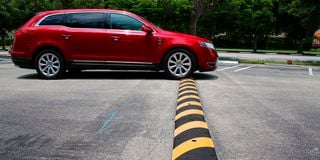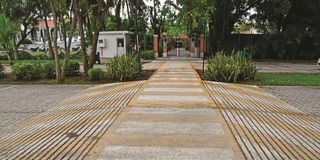Premium
How many of Kenya’s 10,000 speed bumps conform to the law?

A car stops at a speed bump.
Gavin,
If I want to build a speed bump on a road near my house, do I need to get permission? Are there any rules about the materials I use or the shape and size or marking of what I build, or where I build it? Can my neighbours build whatever they like, too? As a society, do we need to limit ourselves to the current 10,000 bumps countrywide? Why not 100,000 or a million? That also begs the question: if I do not like a particular bump, can I remove it?
Fred
Short answer: If you do anything to the structure of a public road, you can be prosecuted. Even for properly fixing a pothole! The Kenya Bureau of Standards lists about 2,000 currently approved Standards. Good luck trying to find and get the full text of one called KS 774:2000 which relates to speed bumps.
As to removing a bump you do not like, the Kenya Bureau of Standards does invite any member of the public who suspects any product to be sub-standard to bring a sample to their laboratories.
That prospect might sound tempting and make you smile, but of course it is not recommended if the product is two tonnes of hardened pre-mix tarmac. A photograph instead, maybe, with dimensional evidence.
Longer answer: Any speed bump on an otherwise regular road surface is a potential hazard and is intrinsically disruptive to a road’s core purpose. It increases the time and cost of every vehicle’s journey, it generates more toxic exhaust fumes, brake lining and rubber dust, creates considerable extra noise and causes vibration (that can ultimately damage buildings) in the area. Clearly, regulation of such obstacles cannot be informal – each and every one needs to be individually “licenced” even more strictly than individual drivers and vehicles. Because negative side-effects can be so serious, this is how diligent the investigation must be before a speed bump is authorised:
The internationally recognised process demands that a request for a bump be petitioned, an adjudicating authority be appointed, ambient speeds, traffic levels and accident data be assessed and benchmarked, the proximity of at-risk people and sidewalks and alternative safety measures be considered, and the public (stakeholders) be consulted by mailshot and at a public meeting, and that the vote-majority of those in the project area should be 70:30 or more in favour.
The project area guideline is at least 100 metres before the first bump and after the last bump, and a similar distance on either side of the bumped stretch of road. That is how far intensive side effects will spread.
If the petition is granted, the bump(s) should conform to a prescribed technical design of height, width, length, shape, spacing, advance warning signs, road surface painting, and reflective location pegs at the bump itself. The warning signs should preferably include rumble strips in case signs and markings are lost and/or visibility is poor.
Once the bump is constructed it must be inspected for compliance with all the requisite design parameters, and its effectiveness must be evidenced by monitoring the factors cited in the original petition. If speeds, traffic levels and accident data are not significantly changed for the better, the bump should be removed (to ameliorate the many downsides of the bump remedy).
If we accept those definitions as the law, then the good news is that Kenya only has a few dozen speed bumps. The other mounds of tarmac constructed on our highways and byways (there are many, many thousands of them) are obstructive to traffic, damaging to vehicles, cause unwarranted discomfort to motorists, can damage cargo, and can even cause loss of control. All of these consequences are specifically forbidden by KS 774, so whatever you choose to call them, they are not speed bumps by legal definition.
The issue is not about some non-compliant mounds in some places. It is that virtually all the mounds, virtually everywhere, are in contravention – and their lack of legal compliance is not marginal, it is massive. In terms of combined height, gradient length, shape and speed limit location, I would estimate that our “average” speed bumps are between four and 10 times more severe than KS 774 intends or allows.

Speed bumps.
The legal limit for the height of a speed bump is in most cases 10cm, and only in exceptional circumstances where traffic needs to be brought to a near-halt, 15cm. Never more than that. Kenya is riddled with bumps that are more than double the height limit.
More significantly, the length of a bump should be at least 40 times its peak height. In the most exceptional circumstances a sharpness of 1:20 is permitted, normally reserved for car parks and very low speed roads which already have a limit of 50kph or less.
Kenyan roads – even major highways designed for ambient speeds up to 100kph - are riddled with bumps, some with ratios of 1:10 or worse (which is akin to placing a tree-trunk sized log across the road). Many are also more than twice as high as the maximum limit and less than half the specified length. And they are completely unmarked and sometimes in the shadow of roadside trees.
The key question, yet to be answered, is: Do Kenya Standards mean anything? Are they just a suggestion (which each of us can follow or completely ignore), or do they constitute a legal requirement?
If they are legally binding, it follows that anybody who builds a speed bump which does not comply with the Standard is not just doing a bad job, but is committing an offence!
Most motorists understand the need for bumps (and even more particularly for more moderate versions known as speed humps or speed tables). Properly built in the proper place and properly marked, they can help make the motoring environment calmer and safer.
Compliant tables, humps and bumps may need to be prevalent on low-speed streets. They should almost never be used on open highways. If and where that does become necessary, a useful model to follow would be the bumps on Nairobi’s Southern Bypass, on a steep downhill on the dual carriageway from Kikuyu when nearing Dagoretti.
These work well because they observe the design principle, that a speed bump should deter excessively high speed but inflict no damage, delay or discomfort to vehicles travelling at up to 85 percent of the prevailing speed limit.
In the pipeline: Tax that deters quality and incentivises junk
What is most important where the rubber meets the road?

Lewis Hamilton Mercedes AMG f1 car 3D Illustration, 30 Jun, 2022, Sao Paulo, Brazil.
Formula 1 racing is about the absolute limits of vehicle performance and control, and the difference between the best and the rest in what must be thousands of small details is only tiny fractions of a second. Yet during a race there is one element which seems to make ten times more difference than everything else put together. That is the hardness and wear of the tyres. Are there any lessons to be learned from that in ordinary motoring?
Christopher
Only one. That tyres are fundamental to performance and control of any motor vehicle. Crucial in motorsport; important in a trip to the shops. Tyres, after all, are your vehicle’s only direct connection with mother earth. They stand between you and every nuance of any road surface, both in their own right and as a member of the team called “the suspension system”. They ultimately transmit every instruction you give by steering, accelerator or brakes.
But ordinary motoring is not about “absolute limits” and milliseconds of difference are irrelevant. There is a lot more tolerance available. “About right” is as good as it needs to get.
Presuming the tyres on your car are the right size for the wheel rims they are fitted to, what’s the most important thing about them? Right. They need to be filled with, and retain, air. Without that they don’t work at all. And without the right amount of air (the correct pressure) they don’t work well and control decreases.

Formula 1 World Championship.
Next most important? The tyre casing should be sound – no cuts or bulges in the sidewalls. These represent an extremely high risk of a blow-out.
Third on the priority list? They need to have a decent depth of tread – especially in the rainy season to give grip and prevent aquaplaning, but in dry times, too, for strength and puncture resistance.
With those three ingredients – correct air pressure, sound casing and healthy tread - you have a basically functional and generally safe tyre. But there are dozens of other variables – aye, dozens – that can have a significant impact on your motoring experience.
Even without changing the wheels rims, you have choices of brand, tread pattern, thinner or wider shapes, different profiles (height of sidewall), casing construction options (kevlar, steel or fibre-braced etc), casing speed ratings (SR, HR, VR etc), tubed or tubeless, the number of ply, hardness and softness of the rubber compound…
…and of course there’s the option of changing the wheel rims to other materials or designs or sizes that open up another whole range of tyre options. Then there’s a further dimension of balancing and alignment, castor angles…

New car tyres.
In sum, an enormous scope of choice. And everything in life that offers a choice requires a decision. It’s up to you whether your decisions are well-informed or pure guesswork. If you don’t know all the techy stuff yourself, using a supplier (or adviser) who does is probably a good idea.
Happily, motor manufacturers make an initial decision for you. They decide a type, size and specification of tyre, and recommend pressures which will give the best possible service over a “catch-all” variety of normal motoring conditions. Stick to what they suggest, and you will never go far wrong. But you will also never be exactly right.
There are, without any doubt, specifications which will give superior service in some respects, but worse service in others. The menu of “respects” includes safety, reliability, comfort, wear-life, fuel economy, speed, puncture resistance, traction on varied road surfaces, different loads, ground clearance, gearing, handling…
Bottom line, if most of your motoring is in the “normal” range of everything, stick to the tyres the vehicle’s manufacturer recommends, but if part or much of your motoring is extreme in any way, bear in mind that tyres could be a significant element of any solution.
Do you have a Motoring question? Email [email protected]





